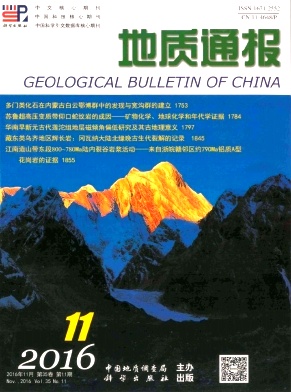| [1] |
Yin A, Harrison T M. Geologic evolution of the Himalayan-Tibetan orogeny[J]. Annual Review of Earth and Planetary Sciences, 2000, 28:211-280.
Google Scholar
|
| [2] |
Metcalfe I. Late Palaeozoic and Mesozoic tectonic and palaeogeographic evolution of SE Asia[J]. Geological Society London Special Publications, 2009, 315:7-23.
Google Scholar
|
| [3] |
Metcalfe I. Gondwana dispersion and Asian accretion:Tectonic and palaeogeographic evolution of eastern Tethys[J]. Journal of Asian Earth Sciences, 2013, 66:1-33.
Google Scholar
|
| [4] |
Stampfli G M, Borel G D. A plate tectonic model for the Paleozoic and Mesozoic constrained by dynamic plate boundaries and restored synthetic oceanic isochrones[J]. Earth and Planetary Science Letters, 2002, 196(1/2):17-33.
Google Scholar
|
| [5] |
Pan G T, Wang L Q, Li R S, et al. Tectonic evolution of the Qinghai-Tibet Plateau[J]. Journal of Asian Earth Sciences, 2012, 53:3-14.
Google Scholar
|
| [6] |
Zhai Q G, Li C, Wang J, et al. SHRIMP U-Pb dating and Hf isotopic analyses of zircons from the mafic dyke swarms in central Qiangtang area, Northern[J]. Chinese Science Bulletin, 2009, 54(13):2279-2285.
Google Scholar
|
| [7] |
Zhai Q G, Jahn B M, Su L, et al. SHRIMP zircon U-Pb geochronology, geochemistry and Sr-Nd-Hf isotopic compositions of a mafic dyke swarm in the Qiangtang terrane, northern Tibet and geodynamic implications[J]. Lithos, 2013, 174:28-43.
Google Scholar
|
| [8] |
Wang M, Li C, Wu Y W, et al. Geochronology, geochemistry, Hf isotopic compositions and formation mechanism of radial mafic dikes in northern Tibet[J]. International Geology Review, 2014, 56:187-205.
Google Scholar
|
| [9] |
Zhu D C, Mo X X, Zhao Z D, et al. Presence of Permian extension-and arc-type magmatism in southern Tibet:Paleogeographic implications[J]. GSA Bulletin, 2010, 122:197-208.
Google Scholar
|
| [10] |
Garzanti E, Le Fort B, Sciunnach D, et al. First report of Lower Permian basalts in South Tibet:tholeiitic magmatism during breakup and incipient opening of Neotethys[J]. Journal of Asian Earth Sciences, 1999, 17:533-546.
Google Scholar
|
| [11] |
Chauvet F, Lapierre H, Bosch D, et al. Geochemistry of the Panjal Traps basalts (NW Himalaya):records of the Pangea Permian break-up[J]. Bulletin de la Société Géologique de France, 2008, 179:383-395.
Google Scholar
|
| [12] |
李才. 青藏高原龙木错-双湖-澜沧江板块缝合带研究二十年[J]. 地质论评, 2008, 54:105-119.
Google Scholar
|
| [13] |
李才, 谢尧武, 蒋光武, 等. 藏东吉塘地区冈瓦纳相冰海杂砾岩的特征及其意义[J]. 地质通报, 2008, 27(10):1654-1658.
Google Scholar
|
| [14] |
曾庆高, 王保弟, 强巴扎西, 等. 藏东类乌齐地区花岗质片麻岩锆石Cameca U-Pb定年及其地质意义[J]. 地质通报, 2010, 29:1123-1128.
Google Scholar
|
| [15] |
Hu P Y, Li C, Li J, et al. Zircon U-Pb-Hf isotopes and wholerock geochemistry of gneissic granites from the Jitang complex in Leiwuqi area, eastern Tibet, China:Record of the closure of the Paleo-Tethys Ocean[J]. Tectonophysics, 2014, 623:83-99.
Google Scholar
|
| [16] |
陶琰, 毕献武, 李金高, 等. 西藏吉塘花岗岩地球化学特征及成因[J]. 岩石学报, 2011, 27:2763-2774.
Google Scholar
|
| [17] |
王保弟, 王立全, 强巴扎西, 等. 早三叠世北澜沧江结合带碰撞作用:类乌齐花岗质片麻岩年代学、地球化学及Hf同位素证据[J]. 岩石学报, 2011, 27:1178-1180.
Google Scholar
|
| [18] |
邱军强, 强巴扎西, 李虎, 等. 澜沧江结合带中二叠世达弄岩片的发现及特征[J]. 地质调查与研究, 2011, 34:258-267.
Google Scholar
|
| [19] |
强巴扎西, 谢尧武, 吴彦旺, 等. 藏东丁青蛇绿岩中堆晶辉长岩锆石SIMS U-Pb定年及其意义[J]. 地质通报, 2009, 28(9):1253-1258.
Google Scholar
|
| [20] |
王玉静, 王建平, 裴放. 西藏丁青蛇绿岩带中一个晚三叠世放射虫动物群[J]. 微体古生物学报, 2002, 19:323-336.
Google Scholar
|
| [21] |
李才, 谢尧武, 董永胜, 等. 藏东类乌齐一带吉塘岩群时代讨论及初步认识[J]. 地质通报, 2009, 28(9):2752-2762.
Google Scholar
|
| [22] |
Ludwing K R. Using Isoplot/Ex, Version 3.00:A Geochronology Toolkit for Microsoft Excel[J]. Berkeley Geochronology Center Special Publications, 2003, 4:1-70.
Google Scholar
|
| [23] |
Wu F Y, Yang J H, Xie L W, et al. Hf isotopic compositions of the standard zircons and baddeleyites used in U-Pb geochronology[J]. Chemical Geology, 2006, 234:105-126.
Google Scholar
|
| [24] |
Woodhead J, Hergt J, Shelley M, et al. Zircon Hf-isotope analysis with an excimer laser, depth profiling, ablation of complex geonmetries and concomitant age estimation[J]. Chemical Geology, 2004, 209:121-135.
Google Scholar
|
| [25] |
吴元保, 郑永飞. 锆石成因矿物学研究及其对U-Pb年龄解释的制约[J]. 科学通报, 2004, 8:1589-1604.
Google Scholar
|
| [26] |
Winchester J A, Floyd P A. Geochemical discrimination of different magma series and their differentiation products using immobile elements[J]. Chemical Geology, 1977, 20:325-343.
Google Scholar
|
| [27] |
Sun S S, McDonough W F. Chemical and isotopic systematics of oceanic basalt:Implications for mantle composition and processes[C]//Saunders A D, Norry M J. Magmatism in the Ocean Basins. Geological Society London Special Publications, 1989, 42:313-345.
Google Scholar
|
| [28] |
Rudnick R L, Fountain D M. Nature and composition of the continental crust:a lower crustal perspective[J]. Reviews of Geophysics, 1995, 33:267-309.
Google Scholar
|
| [29] |
Fitton J G, Saunders A D, Norry M J, et al. Thermal and chemical structure of the Iceland plume[J]. Earth and Planetary Science Letters, 1997, 153:197-208.
Google Scholar
|
| [30] |
Pearce J A, Norry M J. Petrogenetic implications of Ti, Zr, Y, and Nb variations in volcanic-rocks[J]. Contribution to Mineralogy and Petrology, 1979, 69:603-627.
Google Scholar
|
| [31] |
Cabanis B, Lecolle M. Le diagramme La/10-Y/15-Nb/8:un outil pour la discrimination des séries volcaniques et la mise en évidence des processus de mélange et/ou de contamination crustale. Comptes rendus de l'Académie des sciences[J]. Série Ⅱ. Mécanique, physique, chimie, sciences de l'univers, sciences de la terre, 1989, 309:2023-2029.
Google Scholar
|
| [32] |
Lapierre H, Samper A, Bosch D, et al. The Tethyan plume:geochemical diversity of Middle Permian basalts from the Oman rifted margin[J]. Lithos, 2004, 74:167-198.
Google Scholar
|
| [33] |
王明, 李才, 解超明, 等. 藏北羌塘南部冈玛错地区展金组玄武岩的成因及其构造意义[J]. 地质通报, 2014, 33(11):1768-1777.
Google Scholar
|
| [34] |
王明, 李才, 翟庆国, 等. 青藏高原羌塘南部晚古生代地幔柱?——来自基性-超基性岩的地球化学证据[J]. 地质通报, 2010, 29(12):1754-1772.
Google Scholar
|
| [35] |
Zhu D C, Zhao Z D, Niu Y L, et al. 2011. Lhasa terrane in southern Tibet came from Australia[J]. Geology, 39:727-730.
Google Scholar
|
| [36] |
Zhu D C, Zhao Z D, Niu Y L, et al. The origin and pre-Cenozoic evolution of the Tibetan Plateau[J]. Gondwana Research, 2013, 23:1429-1454.
Google Scholar
|






 DownLoad:
DownLoad: